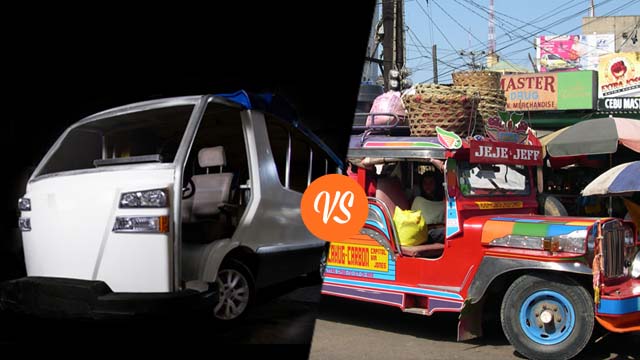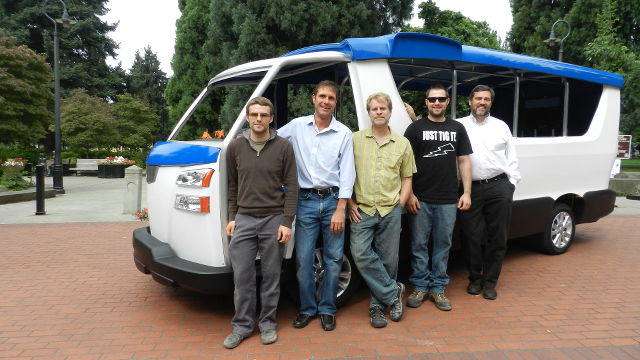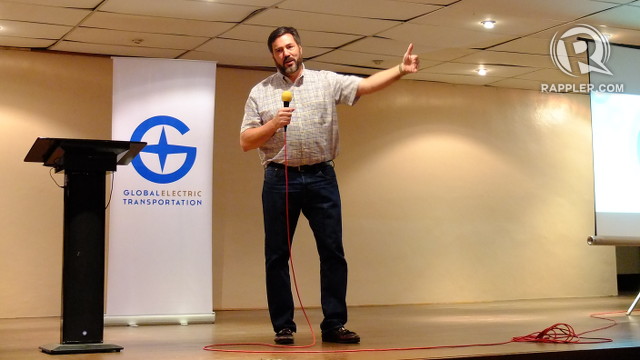SUMMARY
This is AI generated summarization, which may have errors. For context, always refer to the full article.

MANILA, Philippines – Is it time to retire the Philippine jeepney?
Clunky, heavy, noisy and one of the primary suspects of air pollution and chaotic traffic in the metro, many have despaired of the jeepney. Though hailed by some Filipinos as a colorful cultural symbol and war-time legacy, many see the jeep as an embodiment of the outmoded transportation system clogging Philippine streets.
A new electric shuttle wants to replace the jeepney and the system it represents and thrives in.
The COMET (City Optimized Managed Electric Transport) is a fully electric-powered city shuttle designed to render the jeepney obsolete.
Its state-of-the-art lithium ion phosphate batteries lets it travel 80 to 100 kilometers a day until the next battery charge. These batteries can last up to 7 years unlike the lead acid batteries of older e-vehicles which have to be replaced after one year.
Just like the jeep, the COMET is designed for in-city roads instead of major thoroughfares and highways. That’s why it can only go as fast as 60 kilometers/hour, slow for some but quite reasonable given the pace of city traffic.

But more than its equipment, the COMET is revolutionary because of the transport system it employs.
Gone will be the days of “bayad po” (here’s the payment) and “barya lang sa umaga” (change in the morning) because the COMET will employ a cashless system. Passengers buy credit-loaded cards from terminal stations which they tap into the COMET’s built-in scanner when they board the jeep and tap out when they get off.
Instead of jeeps stopping whenever and wherever they want on busy roads, COMETs will have designated stops and terminal stations.
In January 2014, an initial fleet of 30 COMETs will be fully operational. They are set to travel from SM North EDSA in Quezon City to SM Megamall in Mandaluyong passing through Quezon Avenue, University of the Philippines Diliman campus, Katipunan Avenue, Eastwood Libis then Ortigas with stops every 200 to 300 meters.
All these benefits will come at no additional cost to consumers. Consunji said COMET fares will be the same as fares charged for a conventional jeepney ride.
Cashless system, passenger-friendly
The COMET, created by Global Electric Transportation (GET) is designed to right the wrongs of the conventional jeepney by being passenger-friendly and eco-friendly.
That’s why Armi Consunji, director of communications for GET Philippines, is loathe to call it an e-jeep.
“It’s completely different from the jeep. Unlike the cramped jeeps, it has a head clearance of 6 feet so you can stand inside. The doors are on the side not in the back so that passengers can alight from the sidewalk instead of between cars during traffic,” she told Rappler.
The COMET also has wider windows for ventilation and is equipped with GPS, WiFi and a CCTV camera. Each COMET unit is connected to a Command Center through which operators can monitor every COMET driver and vehicle. This way, COMETs can be deployed to places where they are needed or taken out from places where they are only clogging up streets.
Because it uses the most stable lithium battery, it has zero carbon emissions. With less parts and less consumption of fluids, it is 50% more efficient than diesel jeeps. It has a power-steering wheel and high-tech hydraulic disc brakes instead of the drum brakes of regular jeepneys which release more rubber in the air because the brakes put force on the tires which burn against the road surface.
It’s also much lighter than the regular jeep at 2,500 lbs compared to the regular jeep’s 6,000 lbs.
Revolutionizing transport
The 30 COMETs to be unleashed in January are the first in the world. GET CEO Ken Montler said he chose Metro Manila for the pilot release for a reason.
“The Philippines is a great place to showcase what we want to do because we have cities that suffer from congestion, noise and air pollution. We want to give the city back to the people,” he said.
“We’ll take the IT system to manage how transportation moves about our cities and to maximize the efficiency of our vehicles. Most importantly, we’re going to take the drivers and passengers, and make a better world for them.”
Though GET is a US-based company, GET Philippines plans to make the Philippines the primary manufacturing hub for the revolutionary vehicle.
The ideal scenario is manufacturing to be done in the Philippines with some rare parts brought in from other countries. This will create more local jobs and reduce carbon footprint because the product won’t consume as much fuel for transportation to buyers.
The jeep is the king of Metro Manila roads, accounting for 40% of public utility vehicles found in the mega-city’s thoroughfares.
Slowly but surely, COMETs are hoping to match and one day overtake these numbers. Consunji said that 600 COMETs are targetted to come out in the first quarter of 2014. By 2015, 4,000 COMET units will ply the routes of Metro Manila. – Rappler.com
Manila jeepney image from Shutterstock
Add a comment
How does this make you feel?


There are no comments yet. Add your comment to start the conversation.